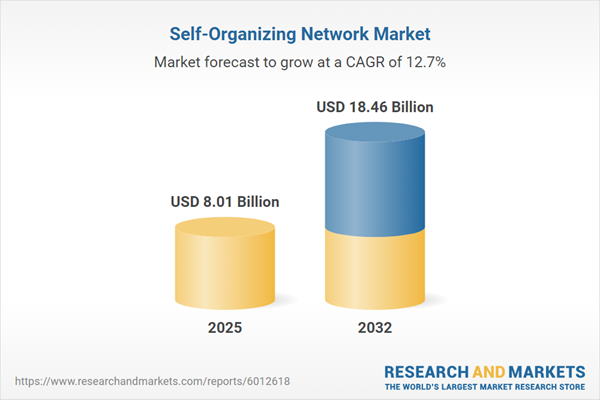Speak directly to the analyst to clarify any post sales queries you may have.
The self-organizing network market is reshaping telecom operations, enabling senior decision-makers to drive network automation, operational flexibility, and digital resilience amid ongoing industry transformation. Intelligent automation empowers organizations to respond to change and strategically scale network resources.
Market Snapshot: Self-Organizing Network Market
The global self-organizing network market is recording strong growth, driven by the rapid adoption of 5G technologies and advanced infrastructure investments. Industry priorities are shifting toward robust network automation, which streamlines resource allocation and allows simplification of intricate operational processes. Backed by advancements in artificial intelligence, machine learning, and cloud-native deployment, telecom organizations can create networks that are both agile and dependable. Regulatory change and expansion of telecom services are accelerating automation, positioning it as a critical pillar in maintaining operational agility and competitive differentiation. Senior telecom leaders are adapting their automation frameworks to protect service reliability and foster ongoing innovation.
Scope & Segmentation in the Self-Organizing Network Market
This report provides a comprehensive overview of the main components and segmentations that shape automation strategies and operational transformation for telecom stakeholders.
- Component: Encompasses telecom hardware, software for core and access networks, and support services such as consulting, integration, and managed solutions across diverse deployment schemes, enabling end-to-end operational flexibility.
- Technology: Addresses the full spectrum from legacy platforms to 5G New Radio, ensuring continuous technology transition and integration in multi-operator environments for seamless connectivity evolution.
- Network Domain: Includes core, radio access, and transport segments, with each domain requiring specialized automation and orchestration to improve network delivery and overall service quality.
- Deployment Mode: Covers macro cell, small cell, and Wi-Fi-centric models, supporting deployment in urban, suburban, and large-scale enterprise environments to meet varying connectivity requirements.
- Application: Incorporates self-configuration, automated optimization, self-healing, and energy management, all aimed at enhancing operational resilience and efficiency.
- End User: Provides tailored solutions for enterprises, telecom service providers, and public sector agencies, supporting their distinct needs for automation, scalability, and operational control.
- Architecture: Features centralized, distributed, and hybrid frameworks to align governance protocols and operational objectives, meeting diverse business requirements.
- Regional Coverage: Outlines market presence across the Americas, Europe, Middle East and Africa, and Asia-Pacific, each characterized by specific regulatory settings and infrastructure developments.
- Leading Companies: Highlights influential vendors such as Huawei Technologies, Ericsson, Nokia, ZTE, NEC, Samsung Electronics, Fujitsu Limited, Cisco Systems, Amdocs, and Mavenir Systems, who drive continuous innovation and market expansion.
Key Takeaways for Senior Decision-Makers
- Integrating artificial intelligence and machine learning into network automation enhances real-time responsiveness and supports evolving user requirements and service portfolios.
- Advancing toward cloud-native and Open RAN environments promotes a robust vendor ecosystem and speeds up the launch of advanced network features.
- Implementing software-defined networking makes it possible for teams to quickly adapt workflows when market conditions or regulatory demands shift, increasing organizational agility.
- Strategic, balanced investment in both hardware and software increases operator control over deployment schedules and network complexity management.
- Recognizing regional differences in spectrum and infrastructure, firms must tailor automation strategies to minimize risk and maximize local alignment.
Tariff Impact: United States Policy Shifts and Global Supply Chains
Recent U.S. tariff adjustments are influencing global telecom supply chains, particularly in the sourcing of semiconductors and critical hardware. Telecom carriers are addressing these changes by diversifying suppliers and building closer partnerships with regional vendors. This trend favors the adoption of software-driven network models to ensure business continuity and support operational flexibility in the face of regulatory and logistical uncertainties. Executive teams are reassessing capital allocation and operating strategies to maintain resilience in a continuously changing environment.
Methodology & Data Sources
This analysis is based on direct engagement with senior executives and technical experts, complemented by a thorough review of leading market research, official regulatory documentation, and curated expert panel insights, ensuring reliability and relevance for senior telecom stakeholders.
Why This Report Matters
- Delivers actionable insights that inform automation investment, empower operational transformation, and drive strategic excellence across telecom organizations.
- Helps senior leaders strengthen compliance and risk mitigation strategies within shifting regulatory frameworks and infrastructure environments.
- Offers benchmarks for peer and regional comparison, equipping decision-makers to guide their organizations and sharpen their market position.
Conclusion
Self-organizing networks are equipping telecom leaders with powerful automation and adaptability. This report supports informed decision-making and efficient network transformation, ensuring organizations stay ahead in an evolving market.
Additional Product Information:
- Purchase of this report includes 1 year online access with quarterly updates.
- This report can be updated on request. Please contact our Customer Experience team using the Ask a Question widget on our website.
Table of Contents
3. Executive Summary
4. Market Overview
7. Cumulative Impact of Artificial Intelligence 2025
Companies Mentioned
The companies profiled in this Self-Organizing Network market report include:- Huawei Technologies Co., Ltd.
- Telefonaktiebolaget LM Ericsson
- Nokia Corporation
- ZTE Corporation
- NEC Corporation
- Samsung Electronics Co., Ltd.
- Fujitsu Limited
- Cisco Systems, Inc.
- Amdocs Limited
- Mavenir Systems, Inc.
Table Information
| Report Attribute | Details |
|---|---|
| No. of Pages | 187 |
| Published | October 2025 |
| Forecast Period | 2025 - 2032 |
| Estimated Market Value ( USD | $ 8.01 Billion |
| Forecasted Market Value ( USD | $ 18.46 Billion |
| Compound Annual Growth Rate | 12.7% |
| Regions Covered | Global |
| No. of Companies Mentioned | 11 |









